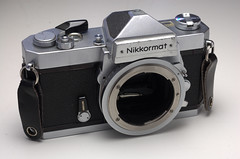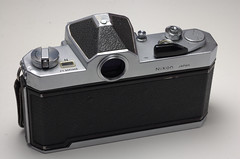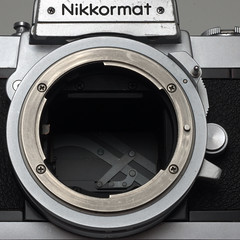Nikomat/Nikkormat FTN

|
| Nikkormat FTN image by Steve Harwood (Image rights) |
Introduction
The Nikomat/Nikkormat FTN Nippon Kōgaku was a successful and lauded iteration of the Nikomat/Nikkormat FT series. Introduced in 1967, the FTN is built on substantially the same chassis as the FT, but had center-weighted metering instead of whole-frame average metering, a shutter-speed display in the viewfinder, a few other minor changes, and, critically, a simplified process for mounting the lens. Nowhere on the body does the camera directly identify itself as an "FTN." The serial number begins with an "FT," probably continuous with the serial numbers of the FT, and there is a larger capital "N" nearby, adjacent to the external meter indicator. The "N" may stand for "new." At any rate, it seems the manufacturers viewed this camera as not a new model but an update.
The Nikkormat series was the budget range of Nikon SLR's, aimed at those who could not afford the professional range (including the Nikon F). However, for several reasons, the Nikkormat achieved a significant following. For one thing, some professionals preferred the smaller, cheaper and simpler Nikkormats. For another, the camera has an extremely reliable metal-blade focal-plane shutter, based on the Copal Square, known for its high X-speed, durability and accuracy. In the eyes of some, this puts it ahead of the Nikon F technically, though it has a fixed finder and no flash shoe. The Copal shutter would be picked up in the professional range at a later date, and in fact the Nikkormat line would become the Nikon FM and Nikon FE series, both of which are well-regarded as budget professional or semi-professional cameras to this day.
In a way, the early Nikkormats can be seen as the successors of the Nikkorex F, a Mamiya-made, Nikon-branded body with the original Copal Square (it was the first SLR to have it). This Nikkorex was a step up from the fixed-lens mass market Nikkorexes, as it takes F-mount lenses and has an optional clip-on meter. In fact, the Nikkorex F filled a new niche for Nippon Kougaku, what we might now call the "prosumer" niche, between amateur and professional-grade equipment. By introducing the metal-blade shutter type and pioneering the marketing strategy, the Nikkorex F paved the way for the Nikkormats and eventually the FM and FE series.
The Nikkormat FTN represents the most common of the FT series Nikkormats, having been made for almost ten years. Its predecessor introduced the body type and most of the basic features, while the FTN drastically improved on the user experience, and the FT2 and FT3 continued to refine the same body style.
The FT notoriously has fully-manual lens indexing-- the film speed is aligned with the maximum aperture of the lens on a double scale around the lens mount. The FTN replaces this with a simple film speed setting and the "double twist" method of attaching the lens which "automatically" indexes the aperture (though this is not identical with Nikon's later "Auto-indexing" lenses, which use an entirely different mechanism)
The FTN was produced until 1976, with minor modifications.
Physical description
The camera is a fairly conventional SLR in the layout of the chassis. However, there are some unusual features that give the camera an unusual look: the shutter speed selector is, as on many fixed-lens cameras, but few SLR's, a ring around the lens mount. This may at first seem like an inconvenience, but it puts both the exposure controls in the same place, and frees up the top of the camera for other things. To wit, the camera features a very large magnified frame counter where many cameras would have the shutter-speed dial, as well as a depth of field preview button that can be mistaken for a second shutter release, closer to the pentaprism. The apparent inconvenience of the shutter-speed ring is also lessened by the fact that the shutter speed is always visible inside the viewfinder, a new feature of the FTN model. The shutter speed is also visible on the opposite side of the ring from the setting lever, with speeds higher than 1/125 (X-speed) in red (indicating that flash sync is usable.)
Another reason for the camera's unusual appearance is the aperture coupling. This assembly is a ring that surrounds the lens mount, with a projecting prong. This device is a necessity of the Nikon F lens system, which reads the aperture via a slotted shoe on the lens's aperture ring. To mount a lens and meter it properly, the aperture must be set to 5.6, the prong must be moved to the far right (facing the camera), the lens must be placed so that the slotted shoe is over the prong and then twisted-counterclockwise until locked in place, and finally, the aperture ring must be turned all the way to the smallest aperture and then all the way to the largest aperture, in order to mechanically set the aperture range in the camera. A small scale on the aperture-sensing ring confirms the maximum aperture, in place of the dual film speed/maximum aperture scales of the FT. This may seem complicated to photographers who are more used to later SLR's, but many would agree that it is preferable to the manual indexing of the predecessor.
Another unusual feature is an external meter needle in addition to the one in the viewfinder. The manual describes this as being a convenience for use at waist-level or when mounted on a tripod.
Unlike the FT, some FTN's, perhaps a majority, have the "Apollo" plastic grip on the advance lever, while earlier examples have the FT's lightly knurled all-metal flat lever that does not protrude from the rear of the camera when folded. The colloquial term "Apollo" references either an urban legend saying that Nikon updated their winding levers for American astronauts to use during the Apollo missions (i.e., while wearing spacesuit gloves) or merely to the idea that astronauts in spacesuits could use the redesigned levers (in itself doubtful--there is a long history of cameras being redesigned for military use under winter conditions where thick gloves would be required, and the controls are universally much larger than standard).
Shutter
The shutter is substantially the design which Mamiya, Yashica and Copal (among others) came together to design in the late 1960's, which was marketed by Copal as the Copal Square and first mounted by Mamiya in the Nikkorex F (and store-brand derivatives). It is a fully-mechanical focal-plane shutter, with the moving elements being six metal blinds being propelled by levers, instead of continuous cloth curtains propelled by rollers. Unlike the Nikkorex Copal Square shutter, the Nikkormat shutter seems to be made in-house, rather than by Copal, and has the levers on the mirror-box side, rather than the film side. Shutter speeds run from 1/1000s to 1s and B, with intermediate speeds available between each shutter speed from 1/1000s to 1/250s. Using the shutter with the selector between other speeds is not recommended by the manual.
The shutter speeds are shown by transparent numbers in a slider moving inside the pentaprism enclosure adjacent to the focusing screen. The current speed is lit by light coming through the lens, as well as the adjacent shutter speeds (or a diamond at each end of the speed range), which are tinted yellow.
Metering
When the maximum aperture and the film speed have finally been properly set, the camera acts as a fairly conventional center-the-needle metered-manual camera, metering with the aperture wide open. The meter is activated by pulling out the film-advance lever slightly, revealing a red dot. There is a needle at the right-hand side of the viewfinder, between a bracket marked with a "-" and one marked with a "+," which were not present on the FT. Confusingly, the plus and minus marks indicates over- and underexposure, respectively; the plus sign, for instance, does not indicate that the exposure should be increased, as some photographers would naturally intuit. If the needle centers with the shutter at "B," the photographer should use a tripod and hold the shutter for two seconds.
The second meter needle merely has a circle to indicate the proper exposure, though "+" and "-" signs were added to the next model.

|

|

|

|
| bayonet and shutter | Nikkor-S 35mm lens images by Harri Haataja (Image rights) |
Links
- Nikkormat FTN at Nikon's History & Technology site
- Manual Camera User's Opinion
- Nikomat & Nikkormat FTN Camera Bodies" in Richard de Stoutz' "Nikon F Collection & Typology"
- Nikkormat FT noir on www.collection-appareils.fr by Sylvain Halgand (in French)
- Nikkormat at Classic Cameras by RaúlM.
- Nikkomat FTn PDF Instruction Manual - English & French at M.Butkus' www.orphancameras.com
- Nikkormat FTn video presentation by YouTuber Kay's Cameras
| Nikon 35mm SLR Cameras | |
|---|---|
| Nikkorex F | Nikon EL2 | Nikon EM | Nikon F | Nikon F2 | Nikon F3 | Nikon F4 | Nikon F5 | Nikon F6 | Nikon F50 | Nikon F55 | Nikon F60 | Nikon F65 | Nikon F70 | Nikon F75 | Nikon F80 | Nikon F90 | Nikon F90X | Nikon F100 | Nikon F-301 | Nikon F-401 | Nikon F-401S | Nikon F-401X | Nikon F-501 | Nikon F-601 | Nikon F-601M | Nikon F-801 | Nikon F-801s | Nikon FA | Nikon FE | Nikon FE2 | Nikon FE10 | Nikon FG | Nikon FG-20 | Nikon FM | Nikon FM2 | Nikon FM2n | Nikon FM3A | Nikon FM10 | |
| Nikomat / Nikkormat | |
| EL | EL2 | ELW | FS | FT | FT2 | FT3 | FTN | |